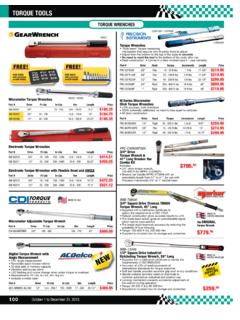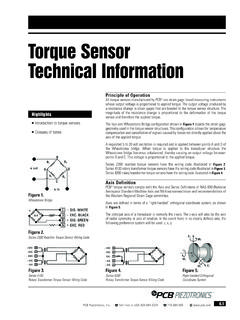Transcription of Measurement uncertainty in torque calibration - …
1 Measurement uncertainty in torque calibrationLuca G. Bochese, ASQ CQE, CRE (Boch - Milano), A. Bochese ( Feanor - Tallinn), : torque , calibration , uncertainty , torque tools, torque - torque calibration on traditional calibration torque calibration of the of reference torque certificate10. Measurement uncertainty11. Acknowledgements12. References13. Acronyms14. Slides1. Introduction - AbstractCalibration of torque Measurement instruments (mainly torque wrenches and torquetesters), even if widely used in the automotive, aviation and building industry, has receivedmuch less attention than other types of instruments ( length Measurement instruments).Very few laboratories offer calibrations services for torque Measurement instruments,compared to length Measurement , pressure, etc.
2 All car manufacturers have developedinternal Measurement systems to measure torque ( braking systems, frictions, etc), butout of these laboratories the specific situation for torque calibration is still torque is given in Nm, the usual way to calibrate such instruments is to use a torquebalance, set the torque tool at the target value ( 40 Nm) and apply reference weights (N)until the requested KP (click point) is reached. The difference between the nominal KP (onthe wrench) and the true KP (measured by the sensor on the torque balance) should be lessthan 4% or 6%, depending from tool presentation focus on calibration of torque Measurement and the comparison betweenthis traditional method ( torque balance) and a new calibration device, also used at the PTBB raunschweig - Germany.
3 Experience shows that the new system applicable to calibrationof torque tools is more effective than traditional torque balance systems, since it tests themin the same operating condition (dynamic) and with very small almost continuous incrementsof forces while torque balance operates almost statically and need discrete massincrements. The new systems is also much faster (requires about 15 minutes for calibrationaccording to ISO 6789) than the traditional torque balance new draft of ISO/CD 6789 (not an international standard yet) is also discussed andcompared with the previous edition of ISO formula for the determination of Measurement uncertainty of a new concept of calibrationdevice is given and briefly experience of a calibration laboratory in Milano (Italy) will give useful hints at thelaboratory level calibration of torque tools (both setting and indicating torque tools) andtesters.
4 Slides show that torque tools from different manufacturers do not operate in asimilar way, some of them shows a distinct KP (clicking point) while other have a smoothcurve with local peaks, in this situation the experience of the laboratory personnel is stillimportant to find out where the correct KP is and some calibration parameters situation is not optimal, since it implies an analysis, and therefore an influence, of thelaboratory personnel and risks to affect the independence of the calibration , tolerance at 4% is a close tolerance and will force manufacturers to improve thedesign and costruction of torque tools components (expecially springs) in order to satisfythese StandardThe standard documents which refer to calibration of these instruments are, respectivelyISO 6789:1992 and DIN 51309, along with DKD guidelines R 3-7 and R 6789:1992 was prepared by ISO TC/29.
5 This Committee is constituted byrepresentatives of torque manufacturers and representatives of research and 6789 is a Committee draft and cancels and replaces the second edition ISO6789:1992, of which it constitutes a technical revision (slide 10). New clauses have beenadded:3 Terms and Design conformance Quality conformance RecalibrationFigures 1 and 2 have been revised, figures 3 have been added, the standard has beeneditorially revised. The document show a strong influence of DIN particular following changes have been introduced with the ISO/CD 6789:1. the change of tolerance (from 4% to 6% tolerance) also for instruments of type II andclasses A and B up to 10 Nm (slide 15). This tolerance was, in the previous edition,accepted only for type C, D and E instruments.
6 The internal friction has a greaterinfluence with small torque values, and thus the original tolerance of 4% has beenenlarged, as requested by torque wrench A period of validity of a calibration certificate has been introduced (12 months as amaximum). This period should be reduced when the tool is frequently Chapter nr. 3 with common terms and definitions has been added. A multilanguagesection would be very useful in future Typical torque curveSlides 2, 3,4,7 and 8 show different shapes of torque vs. time curves for different brands oftype II KP (click point) can sometimes be determined very easily (slide 3 and 4), butsometimes the curve has local peaks (slide 2), is too smooth (slide 8), or shows frictioneffects (slide 7).
7 In this situation the experience of the laboratory personnel is still importantto find out where the correct KP is and set certain parameters on the calibration deviceaccordingly. This parameters are be the rotation speed, the trigger used to select a KP (therequested fall in % of the torque value after the peak, in order to classify it as a true peak, 80%, 85%, 96%, 99%), the angle of rotation, the point where speed reduces (usually at80% of the torque target situation is not optimal, since it implies an analysis, and therefore an influence, of thelaboratory personnel and risks to affect the independence of the calibration looking at the torque manufacturer the laboratory personnel can set followingparameters.)
8 Rotation speed and KP , given the different behaviours of torque wrench brands, it cannot be these curves represent a single Measurement acquisition at a certain torque , 100Nm. ISO 6789 requires a series of 5 Measurement values for each step at 20, 60 and 100%.4. Actual calibration procedureA) torque balanceHaving torque dimensions of force X distance, the traditional calibrating device is constitutedby a torque balance (slide 12) and a set of primary weight this system, the necessary force is obtained using a reference mass, keeping inconsideration the local gravity constant g, in both directions (right and left).The torque is transmitted through a double arm, mounted on an aerostatic radial and axialbearing. This guarantees a transmission of radial and axial forces with a minimum level combination of motor and a transmission with high sensitivity is used to compensate therotation of the information for the correction is obtained through non-contact sensors positioned on thearm.
9 Possible force increments with this system are: 20 Nm, 50 Nm, 100 Nm, 200 Nm, 500Nm and 1000 Nm, each one can be divided in 10 discrete this system a typical Measurement uncertainty of : 5 Nm to 1000 Nm 1 Nm to 5 Nmcan be sensors, torque testers, reference torque tools and torque tools are calibrated withthis torque with torque balance needs skilled laboratory personnel, requires time and, sincewe switch from mass to force, can be influenced by vibrations and by changes of thegravitation constant this system the axis is horizontal and the results contains also the contribution of theweight of the wrench grip (lever effect).Systems with vertical axis are being also developed, to reduce this ) torque testerAfter calibrating the sensor or the reference torque with the promary torque balance, we cantransfer this result to a torque tester (slide 16).
10 These instruments are often used as primaryreference in companies or calibration torque tester should then be mounted on a stable support in Aluminium (slide 13) andused for calibration of torque transmission is needed to reduce the influence of the operator (position of the hand on thegrip, local increase and decrease of speed, expecially close to the click shows that Measurement values change slightly from user to user when such atransmission is not ) torque wrenchFirst of all we should distinguish 2 types of wrenches:1. setting torque tools (indicated as type II wrenches - slide 15)2. indicating torque tools (indicated as type I torque tools slide 14).Type II -setting torque tools (Click torque tools)The release point must be determined at intervals of 20%, 60% and 100% of the maximalnominal torque .



